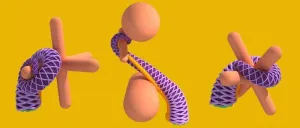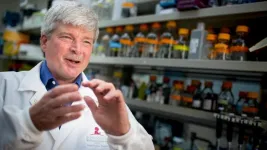For cancer-suppressor genes like BRCA1, researchers have long hypothesized that a single healthy copy could still guard against tumor development. Yet women with one harmful BRCA1 mutation are far more likely to develop breast cancer — a risk traditionally explained by a second mutation that arises later in life, damages the healthy copy of the gene, and triggers disease.
But does this two-hit model tell the whole story?
Likely not, according to the findings of a new study led by scientists at Harvard Medical School.
The research, published Nov.11 Nature Genetics, shows that even in the absence of a second mutational hit, a single faulty copy of BRCA1 renders breast cells more vulnerable to cancer and is sufficient to ignite tumor growth.
“Our work provides an answer to what’s been a lingering question in the field. It shows why and how even a single defective copy of BRCA1 can alter cells in a way that accelerates cancer,” said study senior author Joan Brugge, the Louise Foote Pfeiffer Professor of Cell Biology at HMS. “Our findings show that the two-hit hypothesis of cancer development offers only a partial explanation.”
The research suggests that cells with a single BRCA1mutation can somehow prime breast cells to develop cancer in ways researchers did not fully understand before.
If replicated in further research in humans, the results could inform new therapies that block BRCA1’s priming effect.
“Our results clarify our understanding of how BRCA1-driven breast cancer arises and open up new possibilities for cancer prevention, such as therapies that target the cancer-fueling reprogramming that occurs inside the cell before tumors begin to form,” said study first author Carman Li, a postdoctoral researcher in the Brugge lab.
Such treatments could give people with BRCA1mutations new options for cancer prevention, which are sorely needed. Right now, women with BRCA1alterations can opt for watchful observation, which ensures early detection but does not lower cancer risk; they can take preventive chemotherapy, the benefits of which remain unclear; or they can undergo prophylactic mastectomies that reduce the risk of breast cancer by as much as 95 percent, but the surgery is drastic, life-altering, and expensive.
How defects in the BRCA1 gene fuel tumor growth
Most cancers arise when breaks in a cell’s DNA go undetected and unrepaired, allowing the damaged cell to churn out defective copies of itself. Such DNA breaks are common, but most of the time, they are of little consequence because the body has evolved ways to control cancer through a constellation of genes that monitor cells for DNA damage, repair DNA breaks or, when all else fails, tell defective cells to self-destruct.
BRCA1 belongs to a family of tumor suppressor genes, which make proteins that mend damaged DNA. Generally, a single functioning copy of a gene is sufficient to ensure normal function even when the second copy is defective.
Under this two-hit model, Brugge says, one normal copy of BRCA1 ought to be able to carry out DNA repair even when the other copy is inactivated by an inherited mutation. This means that a total loss of DNA repair capacity doesn’t occur unless the second copy of BRCA1 is also damaged.
A single mutational hit is sufficient to promote cancer
To determine whether the two-hit hypothesis fully explains BRCA1-driven breast cancer, the researchers followed two groups of mice. The first group had one faulty and one normal copy of the BRCA1 gene, while the second one had two normal copies of the gene. Next, the scientists simultaneously turned off the normal copy of the gene in the first group and disabled both normal copies in the second group. This left both mice without any protective BRCA1 function.
Under the two-hit hypothesis, tumors would develop at comparable rates around the same time in both groups. But to the researchers’ surprise that wasn’t the case. The group that had started out with one healthy and one faulty BRCA1 copy developed mammary gland tumors about 20 weeks earlier than the group that had started out with two normally functioning BRCA1 copies but then lost both.
“This indicates that the two-hit hypothesis alone does not explain the earlier incidence of breast cancer in animals with a single defective copy,” Brugge said. “If it were, cancer would have developed at the same time in both groups of mice.”
The observation suggested that it was not just the spontaneous loss of BRCA1 function that accelerated cancer. The presence of an inherited BRCA1 mutation at the outset was also somehow predisposing the first group of mice to cancer.
How one defective copy can prime cells for cancer
But how does a single mutation fuel tumor development?
To answer this question, the researchers compared mammary gland cells from both groups of mice. The cells of the group with a single defective copy of the BRCA1 gene showed telltale changes in the organization and packaging of DNA that render certain cancer-promoting genes more readily accessible. Specifically, these cells contained alterations in the structure and organization of chromatin, the material that helps package and maintain DNA in a cell’s nucleus.
Some of these changes were reminiscent of alterations seen in cells that had already become cancerous. For instance, cells with a single defective BRCA1 copy had chromatin changes that rendered a gene called WNT10A more prone to activation. This gene is known for its roles in regulating cell division and growth. Overactivity in this gene can lead to aberrant cell growth, which promotes cancer. Notably, the chromatin structure around the WNT10A gene became more open and accessible for transcription factors such as JUN to dock and activate its expression, thus leading to a faster ignition of tumor development.
The results also raise broader questions about cancer development beyond breast cancer. One such question is whether similar alterations are present in other BRCA1-related cancers, such as ovarian cancer arising from the fallopian tubes. Another question is whether similar alterations might occur in other cancers driven by inherited genetic mutations.
“We are excited to address these questions in the future,” says Carman Li.
Authorship, funding, disclosures
Additional authors included Alyssa Cordes, Michael U J Oliphant, Mayura Thomas, Laura M. Selfors, Francesca Silvestri, Nomeda Girnius, Gianmarco Rinaldi, Jason J. Zoeller, Hana Shapiro, Christina Tsiobikas, Kushali P. Gupta, all of Harvard Medical School; S. Aidan Quinn, and Cigall Kadoch, Dana-Farber Cancer Institute and Broad Institute; Shailja Pathania, University of Massachusetts; Aviv Regev, Broad Institute and Genentech; and Senthil K. Muthuswamy, Center for Cancer Research at the National Cancer Institute.
This work was supported in part by a Gray Foundation gift, a Susan G. Komen Postdoctoral Fellowship, a Croucher Postdoctoral Fellowship, a Goldberg Family Research Fund gift, a Komen Scholar Award SAC180002, and a National Cancer Institute grant R35 CA242428.
Regev is a co-founder of and equity holder in Celsius Therapeutics, an equity holder in Immunitas. She was a Scientific Advisory Board member of Thermo Fisher Scientific, Syros Pharmaceuticals, Neogene Therapeutics, and Asimov until July 31, 2020. Regev has been an employee of Genentech since August 2020 and has equity in Roche.
END



